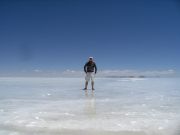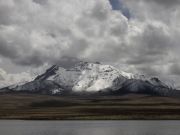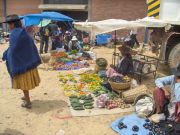The richness of a country is not always measured by money. Regarding this Bolivia is a very poor country, but great things to do and see as its landscapes, cities, friendly people and adventure, make Bolivia one of the richest countries in South America.
|
One of the stars on the Bolivian flag symbolizes Antofagasta region, which now belongs to Chile. It shows Bolivian nostalgia to regain access to the Ocean. As some of the other parts of the country, Antofagasta was lost in the neighbourly wars in the XIX century. Now as a landlocked country, Bolivia covers more than 1 million square kilometres and has more than 11 millions habitants. The country has two capitals – the constitutional in Sucre and La Paz, where the parliament is located. Santa Cruz de la Sierra is the biggest city in the country and the capital of a rich region in gas and oil. The official languages are Spanish, Quechua and Aymara. Traditions and old beliefs are still very strong in the society. Festivals and fiestas are amazingly colourful, but sometimes they might be surprisingly violent for foreigners (like women fistfights). Bolivia has a great diversity of natural wonders like the Amazon jungle on the north, the Altiplano plateau, the Andes mountains, part of the Titicaca lake and Salar de Uyuni - a salt desert that becomes a salt lake after the rainy season.
Although the country is very rich in natural resources, it ranks as one of the poorest on the continent. Run by Evo Morales, Bolivia turned left few years ago and now suffers internal turbulences, as its richer states wants to break away from the country. Every year, Bolivia tightens relations with Hugo Chavez (President of Venezuela). There are/were also some strange ideas of development, like lithium extraction that could destroy the beauty of Salar de Uyuni. Bolivia did not have much luck with its presidents, for in 200 years of independence, Bolivia had more than 90 of them. Many Bolivian presidents had interesting ideas: General Malgarejo, after a dispute with the British Ambassador, expelled him from the country, by placing him naked on a donkey. As revenge, Queen Victoria decided to delete the shape and name of Bolivia from all the maps printed in United Kingdom.
|
|
| Favourite spots: |
Travelling around the country is generally safe and easy, but often very time consuming. The main reason is the unpaved roads; the route from Uyuni to Potosi (app. 170 km) took me more than 7 hours in the dry season. Aerosur, Boliviana de Aviación and TAM are the airlines serving the domestic market, although the tickets are quite expensive.
Crowdie places in the big cities should be avoided, due to the pickpockets. Fake police is a growing problem and, in the cities, taxi sharing is one of the most frequent ways to be robbed. I did not pass through such situation, but heard from other travelers that it happens quite often.
Bolivia is one of the highest located countries in the world. To survive, people often chew coca leafs - they kill the hunger and help to overcome the altitude sickness.
Despite these inconveniences, this is one of the most beautiful and spectacular countries in the world. So, dear traveler, get ready for the adventure of your life.
|
|
| What's really great: |
|
My favourite memory is the bike ride on the most dangerous road in the world (a.k.a El Camino de la Muerte), which until recently was the only road between La Paz and Coroico. The bike ride starts in La Cumbre (4,650 m a.s.l.) and ends in Coroico (1,200 m above sea level). The distance is 64 km and takes about 4 hours to complete. The best way to do it is with a travel agency (Downhill Madness is truly worth the recommendation). They equipped us with trustworthy bicycles and helmets, provided guidance, food and organized our return. The first part of the ride was on a new asphalt road, but the adventure started when we turned into the gravel-paved road. The way was very narrow with immense drop-offs nearby (some with more than 600 meters). We had to be very careful, as the road is still in use and we risked meeting trucks and buses. The road is legendarily dangerous (more than 200 travellers killed every year) and is stamped with crosses marking the spots where vehicles have fallen.
|
|
| Sights: |
 |
 |
 |
 |
 |
 |
 |
 |
Loosing horizons in Salar de Uyuni
 |
 |
Salar de Uyuni is the world's largest salt field. It is located in southwest Bolivia, near the crest of the Andes, 3,650 m. high. Some 40,000 years ago, the area was part of Lake Minchin, a giant prehistoric lake. When the lake dried up, it left behind two modern lakes (Poopo and Uru Uru Lakes) and two major salt deserts (Salar de Coipasa and the larger Uyuni). When the surface is dry, Salar is so white that blinds you and in such moments, the best way to see it is on a bicycle. Don't miss “Isla Pescador”, the island that is an unique place in Salar with great views. After the rainy season, the salt fields are covered by water and it is only possible to go to the Salt Hotel at the beginning of the lake, where we could admire the views or the collection of salt. None of the normal activities were possible. At the borders of Salar, our driver proposed us a ride on the roof of the car. Check if the driver is sober: some time ago, a drunken one caused an accident where 5 tourists died.
|
|
| Accommodations: |
 |
 |
 |
 |
 |
 |
 |
 |
Nevado Sajama, near Chilean border
 |
 |
There are many places to sleep. I slept in hostels (usually inexpensive). In Uyuni, I stayed at the International Hostelling, near the main square (a funny thing was they limited the number of showers per day). The first one was included in the room price, but it couldn’t last longer than 7 minutes. The second (and following) baths were extra paid. In Potosi, I stayed at Hostal Maria Victoria, located near the city centre but in a quiet area with a calm courtyard. Hostal Charcas was my place in Sucre (near the main square); they organise trips to Tarabuco. Hostel Maximilliano in La Paz was the biggest disappointment: not well cleaned, in a noisy neighbourhood and I was beaten by some insects. Prices were usually around 15 USD per double per night.
There are not that many problems to go out. A lot of restaurants, pubs and clubs will allow everybody to chose (it is easy to tell which are for "gringos"). During the evenings, the main squares are the place to be and become very crowded.
|
|
| Nightlife: |
|
Sucre is the constitutional capital of Bolivia and the most pleasant city in the country. The name comes after the revolutionary leader Antonio José de Sucre and, sometimes, it is called “the white city of Americas”. It was where the independence of Bolivia was declared in 1825 (the original document is kept in “La Casa de la Libertad”). Sucre is also the hometown of one of the oldest universities in the world and of the oldest library in Bolivia. The stopover here was a pleasant surprise during my journey in Bolivia. The town is fulfilled with churches and convents. The most beautiful are the Archbishop’s Palace (1609), the Basilica of San Francisco (1581), the Metropolitan Cathedral (“Capilla de la Virgen de Guadalupe” the middle of the 16th century), the National Library, the House of Freedom, the Convent of San Felipe Neri and others. The greatest view over the city is from the square in front of La Recoleta Museum. The nice city parks are also a good option for spending spare time
|
|
| Hangouts: |
 |
 |
 |
 |
 |
 |
 |
 |
Tarabuco market, vegetable sellers
 |
 |
Bolivian folklore occupies an important position in social life. In remote areas, weekly markets are big events. For the tourist this is a good chance to meet indigenous people and to get to know better the local habits. Unfortunately, some of them were already discovered by massive tourism and they lost their authenticity. I chose to go to Tarabuco, a small town located 65 km away from Sucre. Every Sunday hundreds of people (and some tourists) come here to sell and buy food, handcrafts, clothes, blankets and souvenirs. Stands spread all over the town and there is a big hall, converted to a huge eatery with local delicacies. People from remote villages coming here still wear traditional clothes and headgears (typical for Yampara people). It is a good idea to buy their beautiful souvenirs: for us it is a small price, but for them is a substantial source of income for their family budget. Another good reason to visit Tarabuco is the wonderful views on the road to Sucre.
|
|
| Restaurants: |
|
As in other South American countries, meat ("carne") is the most popular food. Many restaurants serve lamb, chicken, fish and beef, which come with rice and vegetables. Hot dogs are popular quick eats. One of the most controversial meats is guinea pig (roasted or cooked), which is one of Bolivian delicacies. The beer is the most popular alcoholic drink and Huari and La Paz are the best known. During the local fiestas, a lot of spirits are consumed. I have two main memories from Bolivian food. The first was on the Chilean border, where we had a breakfast at 4.000 m. We just had simple sandwiches with cheese, but the scenery of high mountains made it the most memorable in my life. The second is less pleasant: in the restaurant El Fogon in Potosi, I chose a simple (so I thought) dish but, unfortunately, it was a trap for the tourists. The food was filled with jalapeno (a spicy pepper) without that being marked in the menu (as others were). I choked to the entertainment of the staff.
|
|
| Other recommendations: |
|
Potosi was founded in 1546 as a mining town and it soon became the wealthiest and biggest in the Americas, with its population exceeding 200,000 people. It is claimed to be the highest located city in the world by elevation at a nominal 4,090 m. It lies in the shadow of the "Cerro de Potosi" or “Cerro Rico” - a mountain popularly conceived of as being "made of" silver ore and that has always dominated the city. Potosi built its richness on the silver extracted here since the XVI century (it was the main supplier of silver for the Spanish Crown for ages). Unfortunately, when the silver finished, the city’s importance declined and now it is among the poorest in Bolivia. The mine is still in use by “cooperativos” and can be visited, to see the harsh working conditions of the miners. There are many architectural gems like the National Mint (“La Casa de Moneda”, built between 1753 – 1773), the Igreja de San Francisco, La Catedral, the Igreja de Santa Monica and many Spanish style houses.
|
|
Published on Thursday July 28th, 2016
|
|
 Publish on Facebook
Publish on Facebook
|
Sun, Aug 21 2016 - 03:21 PM
 by mistybleu
| A really nice read. Bolivia is such a lovely country. |
Thu, Jul 28 2016 - 03:21 PM
 by pictor by pictor
| Excellent reading including two of my favourite things, cycling and jalapenos ;-) |
| Information: |
| Login if you are a member, or sign up for a free membership to rate this report and to earn globo points! |
|
| Bolivia |
|
|
 |
| Cambodia |
|
|
 |
| Chile |
|
|
 |
| China |
|
|
 |
| Czech Republic |
|
|
 |
| France |
|
|
|
|
|
|
|
|
 |
| Hungary |
|
|
 |
| Lithuania |
|
|
 |
| Macedonia |
|
|
 |
| Portugal |
|
|
|

|
